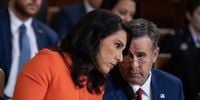In a move that has rattled the U.S. intelligence community and sparked fierce debate in Washington, Tulsi Gabbard, the Director of National Intelligence, has revoked the security clearances of 37 current and former intelligence officials, including top CIA analysts and undercover operatives. The decision, announced on August 19, 2025, and publicized via the social media platform X, has been described by critics and insiders as not only unprecedented, but also potentially dangerous for both national security and the integrity of U.S. intelligence agencies.
According to The Wall Street Journal, Gabbard’s list targeted individuals who had played prominent roles in analyzing Russia’s interference in the 2016 U.S. presidential election and those who had signed public letters supporting the impeachment of President Donald Trump. The list, which included a veteran Russia and Eurasia specialist with over two decades of experience, was published without adequate consultation with the Central Intelligence Agency—a move that blindsided many within the intelligence community.
Perhaps most alarming to intelligence professionals was Gabbard’s public revelation of the name of a CIA operative who had previously worked undercover in Russia. As reported by The Washington Post, this operative had recently helped prepare President Trump for his August 15 summit with Russian President Vladimir Putin and was slated for a sensitive overseas posting, approved by CIA Director John Ratcliffe. The sudden revocation of her clearance, along with the public disclosure of her identity, has ended her 29-year career and raised fears for her safety and the security of ongoing intelligence operations.
Sources familiar with the events told The Wall Street Journal and The Washington Post that Gabbard and her team did not consult with the CIA before releasing the list. In fact, the list was only delivered to the CIA the evening before it was posted on X. According to one intelligence official, Gabbard was unaware that one of the individuals named had conducted undercover work in Russia. Larry Pfeiffer, a former chief of staff at the CIA, minced no words in his criticism: “A smart [director of national intelligence] would have consulted with CIA,” he told the Journal. “It could potentially put CIA cover procedures at risk. It could put relations with foreign governments at risk.”
The backlash within the intelligence community has been swift and severe. Many see the move as a politically motivated purge, orchestrated by President Trump and Gabbard, to remove those perceived as disloyal or critical of the administration. During a July 2025 Oval Office meeting, Gabbard reportedly handed President Trump the list of names, to which he responded that they should be fired. The August 19 memo, signed by Gabbard and posted publicly, accused the targeted officials of “abusing the public trust by politicizing and manipulating intelligence, leaking classified intelligence without authorization, and/or committing intentional egregious violations of tradecraft standards.”
Most of those whose clearances were revoked had been involved in assessments regarding Russia’s influence in the 2016 election or had called for Trump’s impeachment. The list also included senior officials from the National Security Agency, Cyber Command, and the Defense Intelligence Agency. One individual on the list, according to the Journal, claimed she had not worked in government or held a security clearance in over a decade, raising further questions about the criteria used for the purge.
Gabbard’s actions have also extended beyond the recent dismissals. She has launched a campaign to discredit the U.S. intelligence community’s assessment that Russian President Vladimir Putin sought to help Trump defeat Hillary Clinton in 2016—a finding that Putin himself later admitted was accurate. Additionally, Gabbard has announced plans to dismantle the Office of the Director of National Intelligence’s (ODNI) Foreign Malign Influence Center, alleging that it had been used by the Biden administration to “justify the suppression of free speech and to censor political opposition.”
Critics argue that these moves are deeply ironic, given Gabbard’s own history of amplifying foreign misinformation in the American public sphere. The controversy has fueled a broader debate about the politicization of intelligence and the potential chilling effect on analysts who may fear reprisal for producing assessments that conflict with the administration’s views. As one former colleague of the ousted Russia analyst told The Washington Post, “If it can happen to her, it can happen to anyone. What analyst in their right mind is going to write something that in any way challenges … what they think the administration’s view is if they think they’re going to get fired over it?”
Adding further complexity to the situation, Gabbard has also restricted the sharing of intelligence related to Ukraine-Russia negotiations, limiting data exchange even among close U.S. allies. This tightening of information flow comes at a time of heightened tensions in Europe, as Western intelligence reports have noted increased Russian drone surveillance over military supply routes in eastern Germany. These developments have raised security concerns among European partners, who now worry that U.S. intelligence cooperation may be hampered by domestic political calculations.
The fallout from Gabbard’s decisions has not been limited to the intelligence community. Legal experts warn that the public disclosure of undercover agents could have serious legal consequences, both for individuals named and for the agencies involved. The move has also strained relationships with foreign intelligence services, which rely on the discretion and professionalism of their American counterparts to protect shared operations and sources.
Supporters of President Trump, however, have welcomed the purge as a long-overdue housecleaning of what they see as a politicized and unaccountable intelligence bureaucracy. Trump himself has described those who acted against him in the past as “enemies,” and has made clear his support for Gabbard’s actions. For these supporters, the dismissals are seen as a necessary step to restore trust and discipline within the intelligence agencies.
As the dust settles, the U.S. intelligence community faces a period of uncertainty and introspection. The abrupt removal of seasoned analysts and the exposure of undercover operatives have left many questioning the future independence and effectiveness of America’s intelligence apparatus. With allies unsettled and adversaries watching closely, the stakes could hardly be higher.
For now, one thing is clear: the reverberations from Tulsi Gabbard’s actions will be felt far beyond the walls of Langley and the corridors of Washington. The balance between national security, political oversight, and the protection of those who serve in the shadows has rarely been more precarious.



